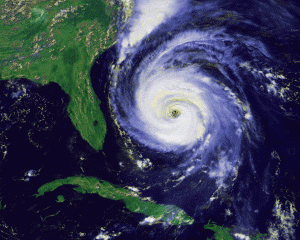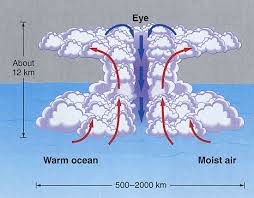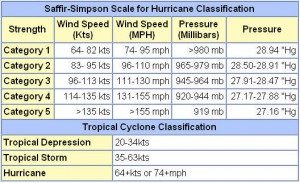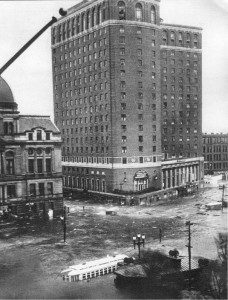Hurricanes
 What are hurricanes?
What are hurricanes?
Hurricanes are a type of tropical cyclone that forms in the Atlantic Ocean. Similar storms form in other oceans around the world. In the Indian Ocean, they are called cyclones, while in the Pacific they are termed typhoons.
 How do hurricanes form?
How do hurricanes form?
Hurricanes begin to form near the tropics, in the Caribbean or in the waters around the Cape Verdean islands of West Africa. Relatively warm surface water evaporates rapidly and then condenses in the atmosphere to form clouds. Moist air rises to saturation and a weather system known as a tropical depression forms.
A tropical depression can evolve into a tropical storm as Earth’s rotation drives rotational winds and air flows into the center. As the weather system spreads over a larger area and develops stronger winds, it can become a hurricane. A cyclone must have sustained winds above 64 miles per hour to be considered a hurricane.

How are hurricanes categorized?
Hurricanes are categorized according to the Saffir-Simpson wind scale, and named by National Weather Service. Until the 1950s, hurricanes were only known by the date that they arrived. Then, the government began to assign the storms common American names. Hurricanes were initially assigned female names, but male names were added after 1979.
The Saffir-Simpson scale ranges from Category 1 to Category 5. Category 1 and 2 storms are generally fairly weak events, like the recent Hurricane Irene, with winds between 74 and 110 miles per hour. They are often accompanied by high waves and heavy rain and knock down some trees and branches. Category 3 and 4 storms are much more destructive, but Category 5 storms are the strongest and rarest events of all. They are capable of destroying all wood frame buildings, leaving only masonry structures standing. The famous of New England Hurricane of 1938 was the last Category 5 storm to hit the region, and Hurricane Andrew in 1992 was the last recorded Category 5 storm.
Does New England the Northeast Get Hurricanes?
Yes. Hurricanes often range far to the north, striking the Northeast and in some cases traveling inland to Ohio and Ontario or farther east to strike Nova Scotia and Newfoundland. New England has experienced many severe hurricanes throughout its history, although the last major storms were in the mid-1950s. A few large storms have struck between the 1950s and today, notably Donna, 1960, Belle, 1976, Gloria, 1985, Bob, 1991, Irene, 2011, and to a lesser extent Sandy in 2012 (although Sandy was remarkably destructive in New York and New Jersey).

What are the worst hurricanes that have ever hit New England?
The early colony of Massachusetts Bay was nearly swept away by a Category 5 hurricane in 1635. Since then, the only other Category 5—and the region’s most destructive storm of all time—was the Hurricane of ’38 in September, 1938, which claimed more than 600 lives. Other serious storms include the 1815 hurricane, which swept Providence harbor and a similar 1821 storm that battered New York City. Several major storms struck in the 20th century after ’38.
A storm in the middle of World War II, the 1944 hurricane was nearly as destructive and four major storms struck between 1954 and 1955. Hurricane Carol and Hurricane Edna struck a week apart in August and September, 1954, flooding Providence and New Bedford, raking the South Coast and even knocking down the steeple of the Old North Church in Boston (made famous by Paul Revere and the American Revolution).
In August, 1955, Hurricane Connie saturated soil and raised river levels with heavy rains. When Hurricane Diane arrived a week later, there was nowhere for rain to go and Massachusetts, Rhode Island and Connecticut witnessed severe flooding. Connecticut’s highways and major bridges were severed and many cities were almost destroyed. In fact, many military veterans who had taken part in World War II compared the damage in Connecticut to the damage inflicted by US warplanes on Germany.
